Firstcall’s Cornucopia of Film
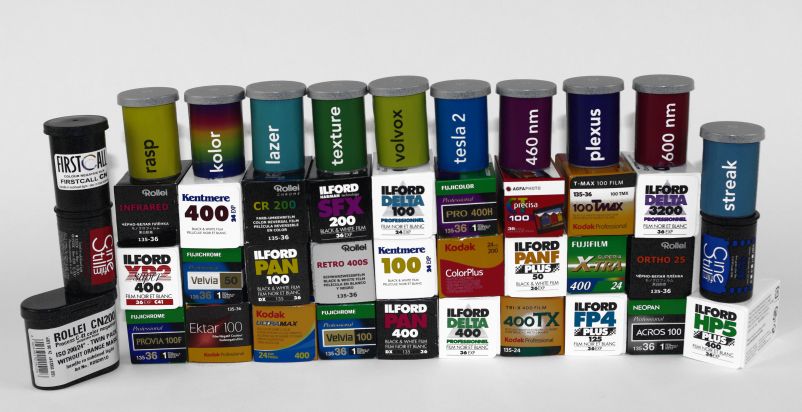
In the last few years, not only have films have been discontinued, but new ones exist and have mainly come from independent suppliers like Fotoimpex and Maco from Germany and Lomography in Austria.
We now offer over 170 films in our company from 14 different vendors.
Read the article and then if you want to order film this month use the code FCFILMFEB and you'll get 10% off any film we sell.

Black-and-white films now offer so-called variants in coloured creative films.
Left: Recording on the tried and tested Kodak Tri-X film (by Ronald Vedrilla). Right: With creative films such as the Rollei Crossbird film, you can achieve interesting picture effects. Here the cross-developed negative on coloured paper was positively enlarged with hard contrasts and strong colours.
Slide film decline
In 2009, there was worldwide mourning when Kodachrome 64 became the last film type of this famous colour film family following the previous demise of Ektachrome and Elite Chrome films. In 2003, the Solaris Chrome 100 was the last slide film from Ferrania. However, there is new hope that the managers of the new “Film Ferrania” will be able to produce a colour reversal film by using the former ScotchChrome again. In the Spring of 2015, the first 500 slide films from “Film Ferrania” were sold to crowd funders.
Fujifilm is still the only manufacturer of colour slide film, if only professional ones, i.e. without Fujichrome Sensia but now without Fujichrome Provia 400X and Fujichrome T64 Professional. Fujifilm has also given up its last Fujicolor FP-100C Professional release sheet film. So there are only integral films like Impossible Project.

Many colour negative films are still available from Fujifilm. Top row: Fujicolor Superia 200, X-TRA 400 and Superia 1600. Bottom row: Also the popular colour-intensive Fujichrome Velvia 50 slide film has remained in the assortment.

Typical contrast reproduction of Kodak colour negative films: left Ektar 100 with saturated colours, right Portra 160 with low contrast, recommended for portraits.
New Wine in Old Bottles
Some films, live on with new pack contents. A typical example of this is the Agfa CT Precisa 100 slide film, which is no longer a residual stock from Leverkusen but a Fujichrome Sensia 100. There is no longer the original film, but its sensitivity class resembles the Fujichrome Provia 100F.

Competitive, inexpensive slide films include the Rolleichrome CR200 (first and the second photo from the left) and AgfaPhoto CT Precisa 100 (third and fourth photo from the left). CT Precisa has slightly stronger colours and a reddish facial tone. The CR 200 works softer with warm colour reproduction.
The CR200 (and similar others) is a “frozen product” from the earlier production and preserved by AgfaPhoto GmbH, Leverkusen, from autumn 2005. They were for sale by Agfa-Gevaert, Mortsel (Belgium) as Aviphot aerial film and are therefore on polyester underlay (PET).
Black and white films are still going strong!
Harman Technology, Kodak and Foma Bohemia produce a large number of different black and white films, with Harman, owners of both Ilford and Kentmere films. Foma and Harman also supply distribution companies such as Adox (see table). Fujifilm only produces the Acros 100 film now.
Black and white photography is very popular among young photographers. It allows a lot of creativity through the variety of films and developers and offers the advantage of a secure long-term archiving. Therefore black and white films are available from well-known and new brands in large volumes. In contrast to colour films, we find special materials also still available such as infrared and high-resolution films. However, the fact that photographers still use black-and-white films and achieve outstanding picture quality with special developers, chemistry manufacturers, like Tetenal or Adox, have great merit too.
Different crystal shapes and film supports
The silver halide crystals contained as light-sensitive building blocks in the film layers form as cubic or tabular. In the latter, they have a certain shape and are patented as "T-Grains" by Kodak. Kodak and Fujifilm both offer these T-Grain type films whereas modern Ilford Delta films contain mixed crystals. Their FP4 Plus and HP5 Plus are proven classics differ in construction but it is their graininess that is popular with many photographers.
The so-called classic films have single or double layers. Their advantages are: they are robust, can handle different light situations (exposures) and developers better. As single-layer films, they are less vulnerable to stray light than multi-layered modern films, but should not be overexposed. Also, thanks to their silver richness, you achieve a good tonal range from white to black and high maximum densities. Also, they are very sharp. Low film sensitivities (ISO 25-50) also offer a very fine grain. Higher sensitivity film nearly always suffers from being more grainy. For the classic film, we always recommend development by hand.
In the case of modern film emulsions, excellent fine-grain is the main focus, especially in small-format films. It is thanks to the dominance of colour film technologies. These films are also more hardened, but in sharpness, contrast range and shadow sketch partial to the classic films. These film types develop better in rotary and continuous process machines.
The tried-and-tested film base is triacetate, the modern ones, which are used in films for home aerial photography and repro photography, but also for conventional recordings, is polyester (PET). The latter has the advantage of being clear, which is why you can use these films as slide film (see below). Also, the polyester film base ensures tear strength, high dimensional stability and long-term stability.
Film and colour sensitivity
The differences in the sensitization of black-and-white films concern the chemical, i.e., the film sensitivity, and the optical, i.e., the colour sensitivity, and thus the tonal value conversion in the image. The film sensitivity is not an absolute value, but only a guideline for a standard development, because a different sensitivity utilisation is achieved depending on the developer used. Not only a low film sensitivity means fine grain and thus a great ability to enlarge the negatives. It’s especially true for high-resolution films, which are well suited for technical applications and experiments. Optically, most films are sensitised panchromatically. They reflect the brightness values of nature very well.

Orthochromatic films are not sensitive to red, so the brick building appears black in the left image. On the right a picture with a panchromatic film that is sensitive to all colours (pictures: Ronald Vedrilla)
The ortho-panchromatic films have a better tonal value transmission by balancing the over-sensitivity of panchromatic films of red. Orthochromatic films are red-sensitive and work harder. The sensitivity of infrared films reaches into the area of high wavelengths that is invisible to the eye. This is also the case, in part, for super panchromatic films, which have an extended red sensitivity.

Infrared films to photograph beyond the visible spectrum, there are still: Left of the Ilford SFX200 with increased red sensitivity and red filter, on the right the Rollei infrared film from Rollei with an infrared filter. The chlorophyll effect is typical: leaf green becomes white. Photos: Ronald Vedrilla
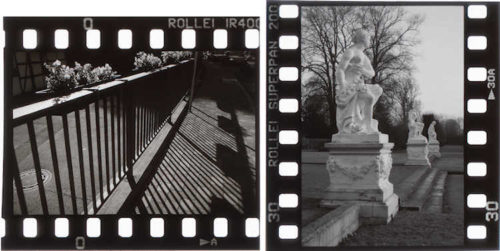
Suitable for black and white slides
Black and white slides can be attractive because of their plastic appearance with a beautiful gradation of their tonal values. The new Adox Scala 160 BW film, which replaces Agfa Scala 200X is our suggestion for obtaining black and white slides.
The Rollei films IR400 (left) and Superpan 200 (right) are ideally suited for reversal development.
Adox Scala 160 is recommended for processing by Photostudio 13 in Leinfelden-Echterdingen (Germany). The full list of film processed as slide films, by Photostudio 13, is available at www.photostudio13.de.
Instant films by Impossible and Fujifilm
The field of use of instant film ranges from party snapshots to full creative images. Impossible Project, with the acquired Polaroid factory in Enschede (Netherlands), has succeeded in improving its instant colour film in the last five years.

Typical instant picture formats for which are newly produced by Impossible (top row) and still by Fujifilm (bottom row) instant pictures. Above left: Film for Image and Image cameras, top right: Film for Polaroid SX 70. Bottom row: Fujicolor Instax wide-screen format.
In the meantime, a considerable range of colour and black-and-white films are offered for the SX-70, Image and other Polaroid cameras, after Polaroid had abandoned film production in 2008. Recently Impossible Project has even launched its new camera with the model I-1. The Impossible range has been expanded to include creative designs. Thus, unlike Polaroid before, there are films with coloured frames and even round images with different frames (picture frame). The table does not list all the versions of the picture frames since they are subject to change. Fujicolor Instax films, and their cameras, often delight amateur party goers with their offering of a smaller picture format.
Cinematic film adapted for 35mm use
The new CineStill films from the USA, come as daylight film 50 Daylight Xpro or 800 Tungsten Xpro. This 800 ISO film means the higher-sensitivity artificial light film is again available. The CineStill films are made from a cinema film produced by Kodak as Vision3 50D film 5203 and Vision 800T 5289 films.

Cinematic material is also suitable for photography. A colour negative film (CineStill 800Tungsten) for recording with artificial light.
The vision films, further improved, have emerged from Eastman Color. The 50Daylight has very fine grain. According to the American Wright brothers, the exposure margin of the CineStill 800Tungsten is ISO 200/24 ° to IS0 3200/36 °. By removing the black back layer in an alkaline bath, the CineStill films have conventional C-41 development.
Incorrect colours and intended mistakes
Lomography, Maco and above all the company Revolog, founded by former photographers in Vienna in 2009, offer many so-called creative films. The Lomography RedScale and Rollei Redbird are the red-sensitive layer upwards spooled films. The yellow filter layer, which serves to turn off the blue light beams for the green and red sensitive layers, is located below the blue-sensitive layer. The blue layer is, therefore, missing on the yellow-red images.
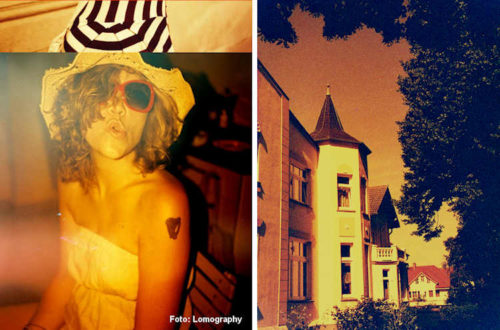
Alienated Colours: On the left a picture with the Lomography RedScale and on the right one with the Rollei Redbird
For the images from the RedScale and Redbird to appear in a faithful altered colour, they must not be corrected for colour balance during processing. For minilabs, therefore, a certain caution is advised, and the yellow-red pronouncements should not be corrected.
Lomography also sells altered slide film with its LomoChrome films: "The special emulsion makes for a colour shift: the result is not only strong blue and violet tones. Turquoise shifts the blue to orange and gold tones and vice versa, so the sky is also orange. The Purple colour turns purple and vice versa. Depending on the exposure, Adox Color Implosion Film alienates the captured subjects in the direction of warm-to-yellowish or cold-bluish, pale or strong. The film material for this is first artificially aged in the heating cabinet and then pre-exposed in colour.
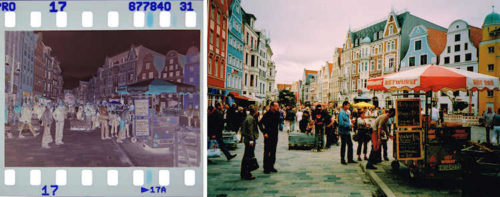
The Rollei Digibase CN 200 provides negatives as an unmasked colour negative film with complementary colours, as well as good black-and-white copying. Its colour rendering is more brilliant than in previous films without colour masking.
Cross-development in C-41
The Rollei Crossbird film is identical to the Rolleichrome CR 200 but is intended for development in the colour negative process C-41. This so-called cross-development produces hard negatives, which are used either as false colour dyes or for coloured paper images in negative or positive colours. Crossbird slides show intense negative colours with a stronger contrast.
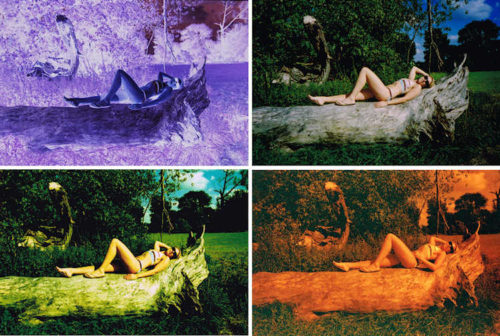
Images of three films for comparison: On the upper left the negative Rollei Crossbird, on the right beside the conventional Kodak Gold 200. Bottom left the positive copy of the Crossbird and on the right an alienated image of the Rollei Redbird.
For example, red becomes blue-green and plant green - very similar to the previous Ektachrome Infrared Film from Kodak - unfortunately no longer produced.
Skin shades appear blue. The negative slides can be projected or scanned. When making paper images, make sure that you develop as if they were from a normal slide, i.e., the negative colours. If on the other hand, you develop the images as if they were negative, they show positive colours, but are very contrasty and coarse-grained.

The colour negative films of Revolog show extraordinary image effects, such as partially wrong colours in "Kolor" (left) or flashes of light in Tesla1 (right). (Photos: Revolog)
Revolog colour films are afflicted with the "errors" described in our table. To do this, they manipulate Kodak ColorPlus films by hand through pre-exposure. These results are loved by amateur experimenters and artistic (fashion and portrait) professionals.
The future of the film market
Black and white films were never affected in the way colour film declined, and now, colour film is seeing growth again. The new creative film can be replicated with image processing software, but that is missing the point. Analogue film users take pictures this way for the sake of passion, curiosity or creative experience. It's about the fun when something unusual is developed.
Impossible, Fujifilm, Lomography and Leica have entered the instant picture market. Fujifilm has also introduced the black and white monochrome film and a new square format (62 x 62 mm) film.
Rollei Chrome 320 film will take the place of CR200 as it runs out. This daylight film, with a higher sensitivity, will be well sought-after.
The Italian manufacturer, Six Gates Films, will be delivering packaged Kodak Vision3 cine films with the black back sheet not removed, as it is in the similar CineStill.
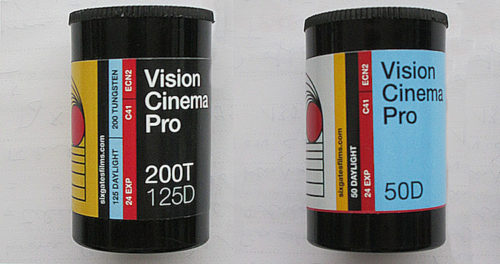
The new "Vision Cinema Pro" is hand-assembled by the Italian manufacturer Six Gates Film
His means they mean processing in Kodak’s ECN-2 process.
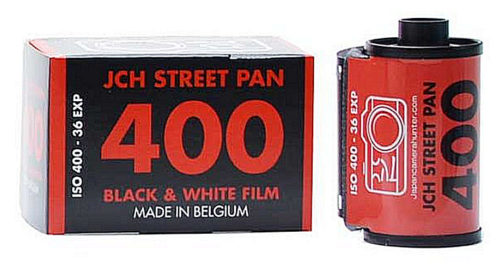
The JCH Street Pan 400 probably originates from the cold store of Agfa-Gevaert and should have been originally designed for the traffic monitoring with its increased red sensitivity (photo: Ars-Imago)
Japan Camera Hunter, supplies the JCH Street Pan 400 film. They are machine loaded on to brand new cassettes specifically manufactured for JCH.
Our Summary of all film currently available
Film type
Art
ISO
Manufacturing
Remarks
Adox Fotowerke (DE)
Adox CHS 100 II
SW
100
135-36, 120, 4x5 "-20x24"
Film with classical imaging and differentiated lights. Clear PET backing with back coating for high sharpness. Available from October 2016
Adox CMS 20 II Prof.
SW
12
135-36, 4 × 135-36, 120, 4 × 120, 4 × 5 ", 30.5 m
Extremely high-resolution orthochromatic thin-film, film on a clear PET base, also available in packs of four with Adotec III developer, exposure as a negative film such as ISO 12 as a slide film such as ISO 16-20
Adox Color Implosion
CD
NOTE:
135-36
Creative film, with exposure at ISO 400 weak brownish-green colours and strong grain, with exposure as ISO 100 yellowish to red colour
Adox Scala 160 BW
SW
160
135-36
New slide film, replaced Agfa Scala 200X with finer grain, high silver application and high contrast range, can be developed in the Fomapan-R set
Adox Silvermax 100 NEW
SW
100
135-36, 30.5m
Panchromatic film with high silver content on a clear triacetate backing, up to 14 levels in the Silver-Max developer, as slide film with warm image tone
Wephota (USA)
Wephota FO 5
SW
2.5
4 × 5 "-40 × 50 cm, DIN and inch formats
Orthochromatic film for negatives to special printing processes (eg cyanotype and impression)
Wephota NP 15
SW
25
6.5 x 9 cm, 4 x 5 ", 5 x 7"
Classic film, corresponds to Rollei RPX 25
Wephota NP 22
SW
100
6.5 x 9-18 x 24 cm and inch formats
Classic film, produced by Foma Bohemia (SZ)
Wephota NP 27
SW
400
6.5 x 9 cm, 8 x 10 "
Classic film, equivalent to Rollei RPX 400
Wephota Ortho 25
SW
25
135-36, 120, 6.5 x 9 cm, 8 x 10 "
Orthochromatic film with fine granularity
Bergger (FR)
BRF 400 plus
SW
400
135-36
Recommended for recording with artificial light, pushable up to ISO 800
Pancro 400
SW
400
4 × 5 ", 8 × 10"
Double layer film with large exposure margin, on clear PET base, 135-36 (on acetate) and 120 (on PET) in preparation
Filmotec (DE)
Orwo UN 54
SW
100
30.5 m
Cine-film, also for the slide film developable (Orwo regulation 4185)
Orwo N 74 plus
SW
400
30.5 m
Improved double-layered film
Foma Bohemia (CZ)
Fomapan 100
ClassicSW
100
135-36, 120, 30.5m
Classical panchromatic film
Fomapan 200 creative
SW
200
135-36, 120, 9x12cm, 4x5 ", 8x10", 30.5m
Classical panchromatic film
Fomapan 400 action
SW
400
135-36, 120, 9x12cm, 4x5 ", 8x10", 30.5m
Classical panchromatic film
Retropan 320 soft
SW
320
9x12cm, 4x5 ", 8x10", 17m, 30.5m
A new film with soft contrasts and wide exposure latitude
Fotoimpex (DE)
CHM 100 Universal
SW
100
135-36
Manufactured by Harman Technologies (GB), Kentmere Film
CHM 400
SW
100
135-36
Manufactured by Harman Technologies (GB), Kentmere Film
CineStill 50 Daylight Xpro C-41
CN
50
135-36, 120
Kodak Vision 3 Kinofilm 50D conforms to daylight, but is suitable for process C-41
CineStill 800 Tungsten Xpro C-41
CN
800
135-36
Kodak Vision 3 Kinofilm 500T is suitable for daylight, but suitable for process C-41
New55
SSB
-
5x 4x5 films
Positive, Negative Films for Polaroid Backs 545
Fujifilm (JPN)
FP 100C Professional
COD
800
10 images (8.5 × 10.8 cm)
Production stopped.
Fujichrome Provia 100 Professional (RDPIII)
CD
100
135-36, 5x120, 4x5 ", 8x10"
Very fine grained slide film
Fujichrome Velvia 50 Professional (RVP50)
CD
50
135-36, 5x120
Especially colour screen film
Fujichrome Velvia 100 Professional (RVP100)
CD
100
135-36, 5x120
Especially colour screen film. 4 × 5 "
Fujicolor C 200
CN
200
2 × 135-36
Production stopped
Fujicolor Instax mini instant film
COD
800
2 × 10 pictures
(6.2 x 4.6 cm)For Instax mini cameras, with white, coloured or designed edges
Fujicolor Instax Wide Instant Film
COD
800
2 × 10 pictures
(6.2 x 9.9 cm)For Instax 210 and Fuji Instax wide cameras
Fujicolor PRO 160NS
CN
160
5 × 120, 4 × 5 "
With medium contrast, portrait film
Production stopped. Stock clearance sale (Aug. 2016)Fujicolor PRO 400H 800 (CH)
CN
400
135-36, 5x120
With fourth colour layer to avoid colour stain with fluorescent tubes (Reala technology)
Fujicolor Superia 200 (CA)
CN
200
135-24, 3 × 135-24, 135-36, 3 × 135-36, 5 × 135-36
Production stopped.
Fujicolor Superia X-TRA 400 (CH)
CN
400
135-36
Fujicolor Superia X-TRA 800 (CH)
CN
800
135-36
With fourth colour layer to avoid colour stain with fluorescent tubes (Reala technology)
Production stopped.Fujicolor Superia X-TRA 1600 (CU)
CN
1600
135-36
A high-speed colour film with a fourth colour layer to avoid colour stain with fluorescent tubes (Reala technology). Production stopped.
Instax mini film
Monochrome (CU)SSB
800
10 pictures 6.2 x 4.6 cm
New black and white film for Instax mini cameras
Neopan Acros
SW
100
135-36, 5x120
Especially fine-grained film with flat silver crystals
Harman Technologies (GB)
Ilford Delta 100 Professional
SW
100
135-24, 135-36, 120, 4x5 ", 30.5m
With flat triple structure crystals, roll film because of clear underlay to the reverse winding (Agfa Scala process), while warm black tone
Ilford Delta 400 Professional
SW
400
135-24, 135-36, 120, 30.5m
With flat triple-crystal crystals, can be exposed to ISO 1600, roll film is suitable for a clear underlay to the reverse winding (Agfa Scala process), while warm black tone
Ilford Delta 3200 Professional
SW
3200
135-36, 120
Layer film with three-layer structure crystals, still fine-grained, basic sensitivity ISO 1000, pushable up to ISO 12'500
Ilford FP4 Plus
SW
125
135-24, 5x135-24, 135-24, 135-36, 5x135-36, 10x135-36, 9x12cm, 4x5 ", 8x10", 17m, 30.5m
Classical panchromatic film, particularly fine-grained, as ISO 80 to 200 can be exposed
Ilford HP5 Plus
SW
400
135-24, 5 × 135-24, 10 × 135-24, 135-36, 5 × 135-36, 10 × 135-36, 9 × 12 cm, 4 × 5 ", 8 × 10"
A classical panchromatic film with high resolution and good shadow transmittance, as can be exposed to ISO 200 to 3200
Ilford Orthoplus
SW
NOTE:
4 × 5 ", 8 × 10"
Orthochromatic film, sensitivity ISO 80 for daylight and ISO 40 for artificial light images
Ilford Pan F Plus
SW
50
135-36, 120, 30.5m
Classical panchromatic film, extremely fine-grained
Ilford SFX 200
SW
200
135-36, 120
With extended red range up to 780 nm for infrared-like images
Ilford XP2 Super
SW
400
135-34, 135-36, 120, 30.5m
Very fine colour green, development in colour process C-41, can be exposed like ISO 50 to 800, best quality at ISO 400
Kentmere 100
SW
100
135-24, 135-36, 30.5m
Cheap classic movie
Kentmere 400
SW
400
135-24, 135-36
Cheap classic movie
Impossible Project (DE / NL)
B & W 600 2.0
SSB
640
8 pictures (7.9 × 7.9cm)
For Polaroid 600 and Impulse cameras, also available for pictures with a black frame
B & W for 8 × 10 cameras and backs
SSB
640
10 Negative + 10 Positive 8 × 10 "
For 8 × 10 instant photo cameras as well as Polaroid back and processor
B & W movie
For I-TypeSSB
640
For new Impossible Camera I-1
B & W for Image & Spectra
SSB
640
8 pictures (9 × 7.3 cm)
For Polaroid Image and Spectra cameras
B & W SX-70
SSB
640
8 pictures (9 × 7.3 cm)
For Polaroid SX-70 camera
Color film
For I-TypeCOD
640
- 7th February 2017









